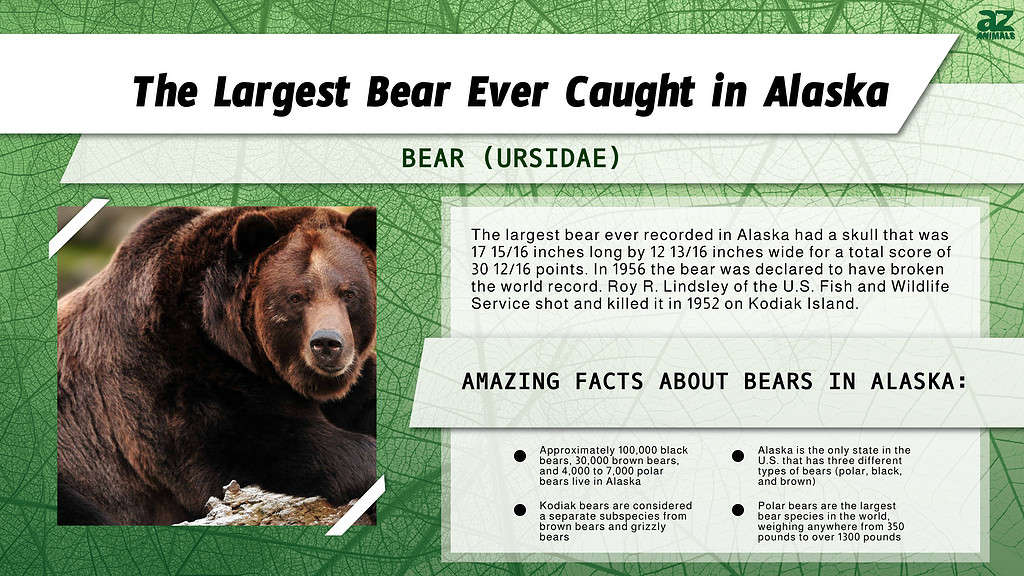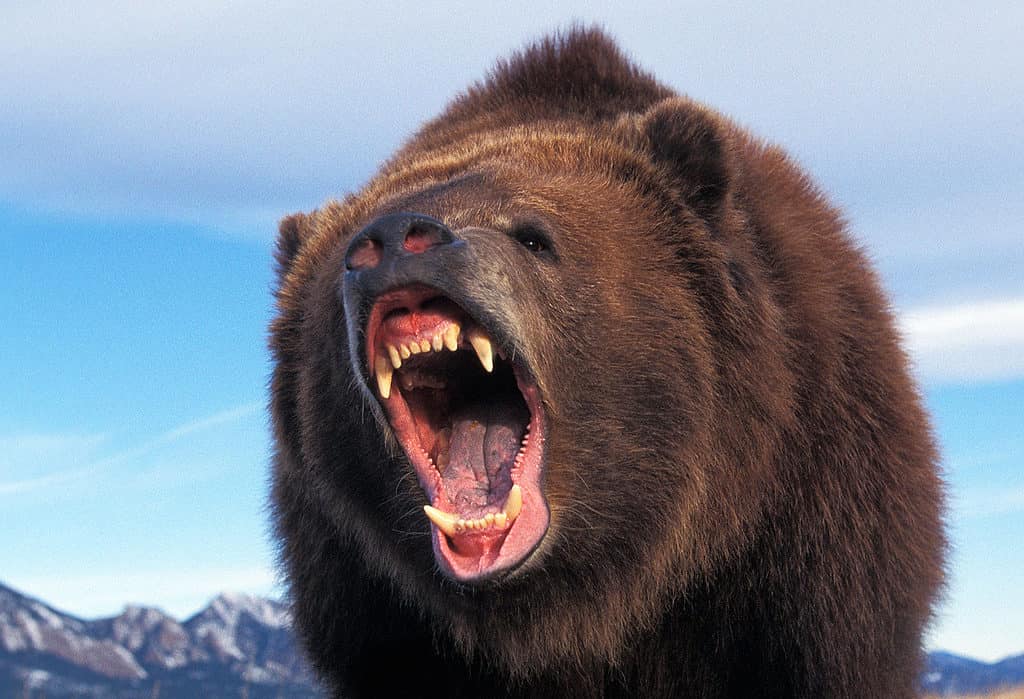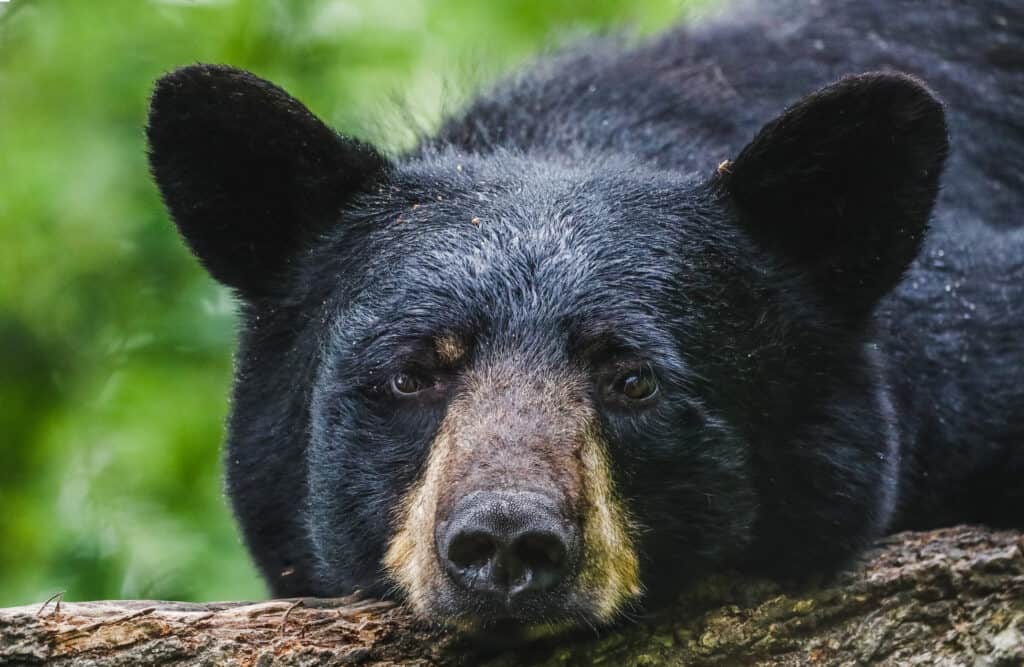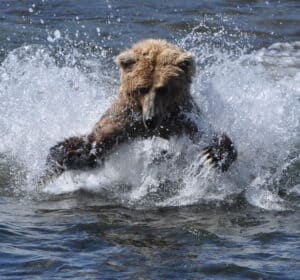Alaska is home to some of the most diverse and abundant wildlife in the world. In Alaska, you’ll find all sorts of creatures, from fish to mammals to reptiles to birds. However, it is the bears who are at the top of the food chain in the state. The state is home to about 70 percent of all North American brown bears and most of the grizzly bears. In addition to that, black bears and Kodiak bears live in the area as well. Because there are so many bears in this area, it comes as no surprise that some of the largest bears have been caught here. Are you curious to find out about the largest bear ever caught in Alaska?
In this article, we will examine what may be the largest bear ever caught in Alaska. Additionally, we’ll discuss what to do if you encounter a bear in the wild.

The Largest Bear Ever Caught In Alaska
As we mentioned above, Alaska is home to many different species of bears. To this day, the record of the largest bear is still up for debate, but here are some contenders for the title.
In 1952, Roy R. Lindsley, an employee of the US Fish and Wildlife Service, shot and killed a huge Alaskan brown bear, which set a world record. This catch was made on Kodiak Island, which is located about 250 miles south of Anchorage and right below Cook Inlet. A brown bear and a grizzly bear are both classified as Ursus arctos, the same species. It is worth noting, however, that Kodiak’s genetically isolated bears exhibit a variety of skull proportions, claw shapes, and dentition that sets them apart from their brown bear counterparts elsewhere in Alaska. Due to these reasons, Kodiak bears are considered a separate subspecies.
The size of Lindsey’s bear skull is 17 15/16 inches long by 12 13/16 inches wide for a total score of 30 12/16 points. In 1954, during the American Museum of Natural History’s sixth awards competition, the bear was declared a world record. The record may have been broken, however, in 2018 when Chris Cammack arrowed a massive Alaskan brown bear. On September 24, 2018, a special scoring session convened by the P&Y Special Panel of Judges in Windsor, Colorado confirmed Chris Cammack’s Alaskan Peninsula brown bear skull measurement was 29 4/16 inches.
Bears In Alaska: Types And Appearances

Kodiak bears are the second largest bears in the world.
©slowmotiongli/Shutterstock.com

Polar bears can also be found in the extreme north and west of the Alaskan tundra.
©Steve Amstrup, Public domain, via Wikimedia Commons – License
Alaska is home to three species of bears. As we mentioned, you can find black bears, brown bears, and polar bears in Alaska. It is important to note that each of these bears has its own unique characteristics. Although three main species of bears exist in Alaska, the American black bear is one of the most commonly seen. Despite being called black, they can be various shades of black, white, or brown. It is common for an adult male black bear to weigh between 180 and 200 pounds. The difference between black bears and brown bears is the black bear’s lack of shoulder hump, smaller claws, bigger ears, and flatter brow lines.
Almost all of Alaska is inhabited by brown bears, with the exception of some islands. Bears of this species are also commonly known as grizzlies. Compared to black bears, brown bears are larger, with an adult male weighing between 300 to 650 pounds. They have very well-developed shoulder muscles, which are used for digging and turning over rocks, giving them a distinctive shoulder hump.
Alaska’s extreme north and west host polar bears on the tundra and ice sheets. There is no doubt that polar bears are very large animals. It is possible for an adult male to weigh anywhere from 350 pounds to more than 1300 pounds! As opposed to what some people think, a polar bear‘s fur is not white. Every hair is actually made up of a hollow tube that is clear. The hollow hairs of polar bears reflect light, which gives them their white color. Underneath, their skin is actually jet black!
Bear Habitat In Alaska
Due to its diverse geographical characteristics and fascinating wildlife, Alaska is among the most fascinating states. In fact, Alaska is the only state in the U.S. that has three different types of bears (polar, black, and brown).
The majority of Alaska’s forested regions are home to black bears. Their range can vary depending on the season from sea level to alpine terrain. Grizzlies, however, are found throughout Alaska except on island chains south of Frederick Sound and west of Unimak in the Aleutian Chain. The polar bear inhabits Alaska’s St. Lawrence Island and sometimes St. Matthew Island and the Kuskokwim Delta in the winter. Summer is the time when polar bears are most abundant in the Chukchi Sea and the Arctic Ocean around the edge of pack ice.
How Many Bears Are There In Alaska?
Approximately 100,000 black bears, 30,000 brown bears, and 4,000 to 7,000 polar bears live in Alaska
There are a lot of bears roaming Alaska’s territory. An estimated 100,000 black bears inhabit Alaska. A total of 98% of U.S. brown bears live in Alaska, and 70% of the total North American brown bear population lives in the state. The number of brown bears in Alaska is estimated to be 30,000. In any given year, hunters harvest about 1,450 of these animals. The only known polar bear population in the United States is found in Alaska. It is estimated that there are between 4,000 and 7,000 individuals in the Alaska polar bear population.
Is It Legal To Hunt Bears In Alaska?

It is legal to hunt bears in Alaska with a hunting license.
©iStock.com/Mandy Fuller Photography
Alaskans are required to have a hunting license to hunt brown/grizzly bears as well as black bears. A black bear hunt may also require a harvest ticket, a drawing permit, or a registration permit and some may require a license only. Unless they are Alaska residents within a second-degree kinship relationship, nonresidents who hunt brown/grizzly bears are required to be accompanied by a licensed Alaska guide. A guide is not required for nonresidents to hunt black bears in Alaska. However, some hunts require a guide if a nonresident is unaccompanied.
What To Do If You Come Across A Bear In The Wild?
When coming face-to-face with a bear in the wild, it can be an intimidating and frightening experience for many people. The bear can, after all, grow to huge proportions. It is for this reason that many of us worry about what to do if we encounter a bear in the wild. Particularly if you live or travel through Alaska, where bears are so common.
However, the truth is that bears are not nearly as unpredictable and dangerous as many would have us believe. In general, they are quiet, shy animals who prefer to stay away from human contact. In actuality, it is quite rare for an attack to take place. As many humans do, bears are often known to defend their personal spaces, since they consider an area around them to be their own. By entering a bear’s personal space, you become a threat, causing it to run away or act aggressively.
Do not panic if you come into close contact with a bear. You should speak to the bear in a normal tone and wave your hands at him to get him to recognize you as a human. Do not run away from the situation, but rather back away slowly. It is also advisable not to make eye contact with them so they will not perceive you as a threat.
Where Is Kodiak Island, Alaska Located On A Map?
Kodiak Island is a large island 30 miles off the south coast of Alaska, in the Gulf of Alaska, which is located in the Kodiak Island Archipelago, an area made up of sixteen major islands that parallel the Katmai Coast along the Alaska Peninsula for 177 miles. Alaska is located in the far upper northwest corner of North America. It is the northern and westernmost state. It is bordered by the Canadian provinces of British Columbia and the Yukon to the east, by the Chukchi and Beaufort Seas to the north, by the Bering Sea to the east, which border it shares with the Russian Federation of Chukotka, and the Pacific Ocean is to the south.
The photo featured at the top of this post is © Lubos Chlubny/Shutterstock.com
Thank you for reading! Have some feedback for us? Contact the AZ Animals editorial team.






